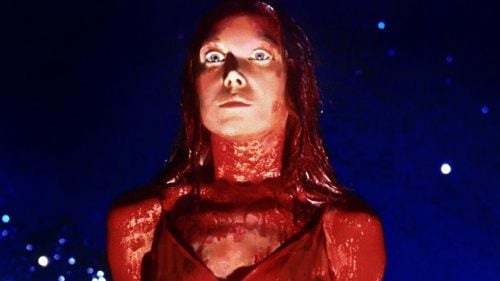The Savage Stack - SALEM’S LOT (1979)
There’s always going to be – for lack of a better term – a stack of films we’ve been meaning to get to. Whether it’s a pile of DVDs and Blu-rays haphazardly amassed atop our television stands, or a seemingly endless digital queue on our respective streaming accounts, there’s simply more movies than time to watch them. This column is here to make that problem worse. Ostensibly an extension of Everybody’s Into Weirdness (may that series rest in peace), The Savage Stack is a compilation of the odd and magnificent motion pictures you probably should be watching instead of popping in The Avengers for the 2,000th time. Not that there’s anything wrong with filmic “comfort food” (God knows we all have titles we frequently return to when we crave that warm and fuzzy feeling), but if you love movies, you should never stop searching for the next title that’s going to make your “To Watch” list that much more insurmountable. Some will be favorites, others oddities, with esoteric eccentricities thrown in for good measure. All in all, a mountain of movies to conquer.
The thirtieth entry into this unbroken backlog is the first (and still best) Stephen King mini-series to air on network TV, Salem’s Lot...

Forty-plus years into Stephen King movies being part of our pop lexicon, it’s sometimes difficult to comprehend where the starting point was for these qualitatively dubious yet constantly diverting horror adaptations. Yet after Brian De Palma’s Carrie was a rather resounding success at the box office (though not the Jaws-level smash the auteur hoped it’d be), producers began buying options to King’s cocaine-fueled library expansion. His second novel (which laid the foundations for what we’d expect from future King texts), Salem’s Lot, was snatched up and then suffered numerous developmental setbacks – including a rejected script from Larry Cohen (which the writer fought and was denied screen credit for). Originally envisioned as a feature, the final product became a two-part CBS Movie of the Week, beginning the miniseries trend that would later be applied to King’s longer (The Stand, It) and shorter (The Langoliers) works.
Tobe Hooper feels like an obvious choice to helm this second filmic foray into King’s terrible universe, and producer Richard Kobritz echoed this sentiment in interviews, citing a single viewing of Hooper’s immortal Texas Chain Saw as birthing the notion in his brain. Hooper replaced George A. Romero, who’d been developing a big screen take on the novel, but abandoned the project once it was shifted to television (Romero didn’t think his concept could survive the format’s content restrictions). However, once the film begins, it’s difficult to recognize Hooper’s particular brand of jangly, hot house sensationalism, as Salem’s Lot is distinctly old fashioned in terms of composition. Utilizing a 1.33 frame fit for a wooden idiot box, the town of Jerusalem’s Lot is bathed in golden sunlight. Exiting a surreal prologue set in a Guatemalan cathedral, we’re introduced to seasoned vampire hunters Ben Mears (singer David Soul), and his surrogate son, Mark Petrie (Lance Kerwin), as they endure their initial battle with pure evil. Hooper’s film is an origin story of sorts, as we flash back to the idyllic New England borough, which is overshadowed by the creepy Marsten house that sits high on the hill. Hooper creates a coziness that clashes with his usual Deep South oddity, lulling us into comfortable submission while we watch from our living rooms, before submerging us in the inky darkness that dominates the Hitchcockian opening credit sequence.
Fidelity to source has always been an issue for King adaptations, and Salem’s Lot is no different. Paul Monash’s screenplay (which the author apparently approves of) takes many liberties with the original text. The basic structure of the story is essentially the same – Mears arriving to the Lot, falling in love with local stunner, Susan Norton (Bonnie Bedelia), and learning that the sleepy municipality houses an ancient bloodsucking evil – but the details have been altered to fit this prime time re-interpretation of King’s self-admittedly favorite tale. The sprawl of Salem’s Lot has been greatly reduced, as numerous characters are either omitted completely, or combined with others so that their traits are adequately represented onscreen. The same goes for a few of the novel’s meandering subplots (as is standard with many King books). However, the biggest point of contention for most fans was transforming master vamp Kurt Barlow (Reggie Nalder) into a grotesque Nosferatu knockoff (pictured on almost all the movie’s marketing), as opposed to the German Count figure he was described as in the book (and played, in the 2004 TNT redux, by Rutger Hauer). Barlow’s crusty, caked makeup is still chilling almost four decades on, and lends the picture a legitimately iconic piece of imagery. Nevertheless, like Stanley Kubrick’s adaptation of The Shining, if a viewer prioritizes faithfulness over visual acumen, there’s certainly a few storytelling hurdles they’ll need to hop over.
Even if transfiguring Barlow into a rather recognizable vampire movie heavy sticks in King fans’ craws, the author’s Maine spirit is preserved. English actor extraordinaire James Mason is perfectly cast as Richard Straker, antiques dealer and keeper of Barlow’s crypt. Mason owns a stuffy superiority over the local yokels who inhabit the Lot. Like many of the story’s elements, he’s a prototype for what would develop into an archetype in King’s “shared universe” (think: Leland Gaunt from Needful Things). Like the inhabitants of Castle Rock or Derry, Jerusalem’s Lot is populated by blue collar working schmoes and their children. Geoffrey Lewis is laying the New England accent on thick with cemetery groundskeeper, Mike Ryerson, while George Dzundza drinks hard and plots to catch his wife Bonnie (Julie Cobb) in the act with her real estate agent boss, Larry Crockett (Fred Willard). Ed Flanders aptly steers Susan’s father from judgmental doctor to unlikely accomplice against the undead, while Kerwin’s horror movie obsessed Tommy Jarvis precursor vows revenge on Barlow after he slaughters his kin. It’s an incredible collection of lumpy, colorful actors, breathing that everyman essence King was keen on crafting with his blunt prose.
Though the movie is undeniably chaste when compared to the rest of his output, Hooper stages and executes some incredibly effective scare sequences that often hinge on corny stingers like freeze frames or sudden jumps. One particularly potent shot of nightmare fuel occurs after Barlow transforms Ralphie Glick (Ronnie Schribner) into his obedient creature of the night. Flanked by swirling mist, Ralphie floats up to the bedroom window of his big brother Danny (Brad Savage), scratching and pleading to be let in. The scene reveals the MO of both the film’s director and the story he’s adapting, cementing the fact that we’re playing by an established set of vampire rules that stretch back to Stoker, only now they’ve been updated for a contemporary American setting that’s sure to hit hard with those at home. This “bump in the night” attitude doubles down during the movie’s climax, which has been shifted to the basement of the Marsten mansion (as opposed to the book’s boarding house climax). A makeshift mausoleum has been constructed by Straker and his Master, the contents of which are made up of their working-class victims, all crawling through the muck to claim another one of their own for eternity. It’s a haunting and dreadful moment, network sensors be damned.
If there’s a glaring flaw in Salem’s Lot, it’s one that isn’t necessarily going to hinder someone watching the movie on Blu-ray in 2017. However, it is interesting to consider what it was like for a home viewing audience in 1979 to experience this movie as it was originally intended – split into two parts. The first half of the film is a slow build, introducing us to the town and its denizens, while the second half is almost wall-to-wall vampire action. It’s a classic case of “saving the good stuff until the end” and it’d be easy to imagine certain audience members changing the channel due to the rather methodical pacing (though ratings for the mini-series certainly prove this theory wrong, as they were high enough that CBS considered developing a weekly Salem’s Lot series). Where ABC’s 1990 childhood-ruiner IT had the inverse problem (with the Losers Club material giving way to a rather dull adult back half), Salem’s Lot takes a minute to get going, but once it does it’s a genuine nail-biter, only second to Chain Saw in terms of intensity in Hooper’s catalogue. The International Cut (which played theaters overseas the next year) is over a full hour shorter, and thus does not share this problem.
As time wore on and King’s brand became culturally ubiquitous, the terror associated with his name (at least when it came to cinematic variations) was diluted. Hooper would suffer his own series of setbacks, as battles with addiction would lead to him getting kicked off several projects before starting to churn out his own substandard genre fare. But for a brief moment in the late seventies, the two shock maestros combined to create one of the more memorable pieces of pop horror to grace a small or large screen. Salem’s Lot is undoubtedly one of the best Stephen King adaptations, and still manages to be scary years after it premiered in homes across the nation.
Salem’s Lot is currently available on Blu-ray from Warner Archive.



